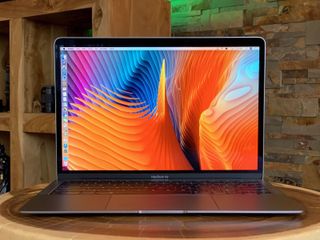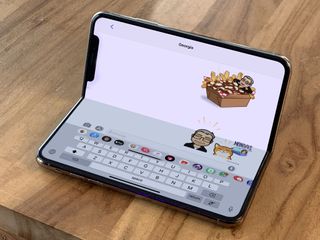Where is Apple's foldable iPhone?

We have an endless thirst for change. I mean, it scares the hell out of us, we hate it, but boredom, now that's annoying. So, whether it's gimmicks like 3D, trends like notches, or game-changers like multitouch, the minute we have one thing, we're already on the lookout for what comes next.
Doesn't matter if they're real or not, doesn't matter if they're practical or not, doesn't matter if they're truly useful or not — all the matters is that they're new and different and potentially exciting.
And right now, that's what I'm calling foldables. And not just phones.
No, this isn't about iPhone 11, but it could be about the future. The Samsung Galaxy Fold is here. So, where's the Apple iPhone Fold?
Foldables: The Past
Foldables aren't new. Humanity has been folding things for… as long as we've had things to fold. Books are the classic of example. But it doesn't stop there. We've folded wallets, we've literally got things called folders, and we even fold up our clothing and our food.

With electronics, we've been folding computers in half for decades — we call them laptops — video games since the Gameboy advanced, and our phones since the early days of cellular. Yeah, hello Moto.
And the reasons are simple, from the practical to the tactile: They can be more efficient to store, they protect the contents, and they're freaking fun to open and close.
Master your iPhone in minutes
iMore offers spot-on advice and guidance from our team of experts, with decades of Apple device experience to lean on. Learn more with iMore!
The storage efficiency is interesting because you're basically trading size in one dimension, the X-axis or the Y-axis, for size in another dimension, namely the Z-axis. In other words, by folding something in half, you're making it half as tall or wide, but twice as thick.

Which may not be a good deal for everything but turns out to be a great one for all the things I listed just a minute ago, and more.
The protection is obvious. If you can prevent things from hitting a breakable screen or falling into the crevices of a precision keyboard, or, sure, yeah, keep all the tasty filling in your turnover until you're ready to eat it, then you greatly reduce the potential for damage, especially while traveling.
The history of humanity is the history of folding things.
And the fun part. Well, yeah. There's a satisfaction that comes from opening and closing something that's made or machined just right, that hits something so visceral in our brainstems. Flip it, click it, clap it, shut it, crack it. It just feels so good.
Again, we've had foldables on our desks for effectively forever. We just called them books and held them up vertically. Now we also call them laptops and rest them down horizontally.
And, we've had foldables in our pockets for a long time too. We just called them wallets and opened them up horizontally. For a while, we also called them phones and flipped them open vertically.
I'm not going to go so far as to say the story of humanity is the story of foldables, but classics are classics for a reason, and when it comes to human technology, foldables are one of the classics.
Foldables: The Present
There's been another trend driving phones and other devices for a long time now, and that's trying to get the most screen into the least space possible.

The original iPhone wasn't the first mostly-screen phone, but it rapidly became the most popular. It was the biggest screen Apple could make work at the time, and at the height of BlackBerry and Palm, they ditched the physical keyboard to achieve it.
Others tried sliders, stackers, or even returned to the flip style for a while, before most simply succumbed to the slab.
Now, we're in the age of iPhone X where the screen goes from curved edge to curved edge, even if we have to put up with a notch or holes or whatever for now to do it.
But, with the Pluses and Maxes and Notes, we've pretty much reached the limits of how much screen we can cram into something that can still credibly be called a phone. At least without turning it into a tablet, and tablets just don't fit in our hands, pockets, or bags the way phones do.
So, now, in order to cram even more screen into something that's still, in some way, within the acceptable width and height of a phone, we're doing what humans have always done — we're going for depth.
We're going for foldables.
Books became laptops. Wallets became flip phones.
There's a couple of different ways we can go with this. We can take the existing big phones and make them small again: Something the size of a Plus or Max or Note that you can fold in half to message or check notifications or complications more easily while you're walking and talking, and pocket or bag more easily when you running.
That would be a fun phone to see, especially for people who love iPhone SE and feel completely underserved by the current, more colossal phone sizes.
But we can also take the existing regular sized phones, the ones that most people can still manage on the go, to do everything we already do on our phones everyday, and turn them into something more like an iPad mini for whenever you want to stop going and start doing — reading, watching, gaming, creating, producing, whatever.
To be truly useful, they'd need screens on the front as well as on the inside. In other words, these books would need covers. So the protection wouldn't be complete. But they'd absolute be as much fun to fold and unfold, open and close, transform and roll out. Sorry, I had to.
Yes, including more mechanics means inviting more mechanical failure, and anything that bends can break, but the utility, the ability to accomplish twice as much with half the stuff, could still make the tradeoff more than meaningful.
Foldables: The Future
Right now, we're not even in the awkward teenage years of foldables. We're like in the terrible twos. The current batch of foldable phones are going to be deeply compromised. Troubled. Bad. Something for the early adopters and tech-curious. And they're going to stay that way, right up until they don't.

Then, and only then, will really find out if they're gimmicks like 3D phones were, everywhere one year, gone the next, or revolutions, like multitouch, where they change everything, forever, at least on the tiniest of time scales.
But what I'm really excited about isn't just phones. It's foldables in general. Foldables: The Next Generation.


I can imagine an iPad mini that folds out into a full-sized iPad that I can use as a bigger canvas, or laptop-style, docked to a keyboard, or even like an iBook, Microsoft courier style. Hey, remember that?
Imagine an iPhone than can unfold into an iPad. An iPad that can unfold into a multitouch Mac display... or control surface.
Or a full-sized iPad that folds out into not just a bigger iPad, but a laptop-like device where top half stays as a screen and the bottom half becomes a topic control surface. Something that uses the same proprioceptive tricks as Force Touch, only much better, to fool our fingers into thinking there are keys there for typing, sliders and dials there for video or audio editing, whatever we need whenever we want.
And sure, maybe we can put it down flat to become a full-sized virtual, tactile control surface for an iMac-sized display, or prop it up and pair it with a physical keyboard to become the a multitouch iMac all its own.
And no, these aren't taster-fridges. These are full-on, freaking kitchenettes.
At least unless and until physical controls and displays are completely obviated by AR — augmented reality — and Voice AI.
Foldables: The Now
So, do I think this year's crop of foldables are going to be any good? No. They're going to be a hot mess. An audacious, adorable, maybe even inspiring hot mess. Same as smartphones were. Same as big phones were. Same as everything is as it crawls its way out of the primordial soup of concept to try and stand on its own two legs of real, mainstream product.
But, as someone who very much loves technology and the future, I'm happy to see companies trying.
Many years ago, longer than ago than most people would think, I heard that Apple was already experimenting with folding phones. It makes sense. They were experimenting with bigger phones back in the iPhone 4 days already, long before they shipped iPhone 6. It took that long until Apple was happy with the technology. Same with OLED in iPhone X.
I imagine they've been experimenting with folding devices, off and on, for just as long. Maybe longer. Trying to figure out something that's not just different but significantly better than what they can do without folding. And I don't expect them to ship anything unless and until they figure out exactly that.
Originally published February 5, 2019. Updated with links to the Samsung Galaxy Fold hands-on.

Rene Ritchie is one of the most respected Apple analysts in the business, reaching a combined audience of over 40 million readers a month. His YouTube channel, Vector, has over 90 thousand subscribers and 14 million views and his podcasts, including Debug, have been downloaded over 20 million times. He also regularly co-hosts MacBreak Weekly for the TWiT network and co-hosted CES Live! and Talk Mobile. Based in Montreal, Rene is a former director of product marketing, web developer, and graphic designer. He's authored several books and appeared on numerous television and radio segments to discuss Apple and the technology industry. When not working, he likes to cook, grapple, and spend time with his friends and family.
Most Popular



